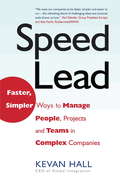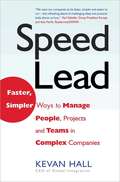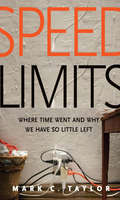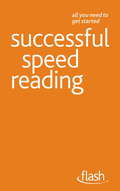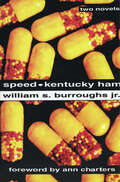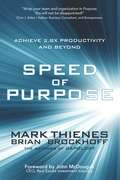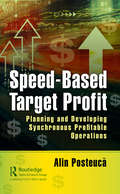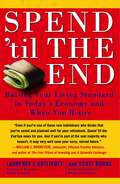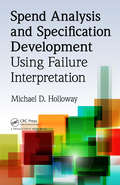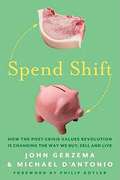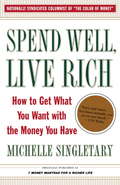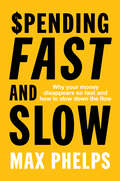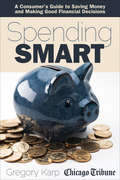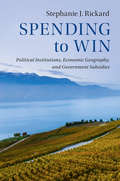- Table View
- List View
Speed Lead
by Kevan HallAuthor Kevan Hall believes that up to 50% of employee time is wasted in most offices. Speed Lead offers a simple solution for making companies run faster. Based on research showing that talented people spend more than 80% of their time on cooperation, communication, and control in the workplace, Hall explains the strategies that work for today's successful businesses.
Speed Lead: Faster, Simpler Ways to Manage People, Projects and Teams in Complex Companies
by Kevan HallAuthor Kevan Hall believes that up to 50% of employee time is wasted in most offices. Speed Lead offers a simple solution for making companies run faster. Based on research showing that talented people spend more than 80% of their time on cooperation, communication, and control in the workplace, Hall explains the strategies that work for today’s successful businesses.
Speed Lead: Faster, Simpler Ways to Manage People, Projects and Teams in Complex Companies
by Kevan HallToday's managers waste an estimated 40 per cent of their time on unnecessary cooperation, communication and control. Old-fashioned management skills are too expensive and slow to use in today's complex companies. When great companies grow they become more complex. This complexity starts to undermine what made the company successful: the organisation slows down, it is more difficult to get things done and it becomes a less satisfying workplace. In his work with talented people from hundreds of the world's leading companies. Kevan discovered that they spend over 80 per cent of their time on cooperation, communication and control - and that up to 50 per cent of that time is wasted. Organised around 4 Cs - Cooperation, Communication, Control and Community - "Speed Lead" distills the experience of more than 35,000 people in over 200 of the world's leading companies. The resulting radical view has enabled organizations to unravel the spaghetti of complexity, reduce project cycle times, build closer business relationships and curb the costs of unnecessary travel. Contrary to current leadership wisdom, "Speed Lead" advises to: celebrate the end of teams where you don't need them; abolish meetings of the bored; take control of the "crack-berry" and don't be a 24-hour control freak; expect more from your people and lead a lot less; make "good-enough" decisions; and, don't let diversity be a diversion - share practices, not values.
Speed Limits: Where Time Went and Why We Have So Little Left
by Mark C. TaylorA contemplation on &“the durability of our fast-tracked, multitasked modern world . . . a stimulating cautionary report for the digital age.&”—Kirkus Reviews We live in an ever-accelerating world: faster computers, markets, food, fashion, product cycles, minds, bodies, kids, lives. When did everything start moving so fast? Why does speed seem so inevitable? Is faster always better? Drawing together developments in religion, philosophy, art, technology, fashion, and finance, Mark C. Taylor presents an original and rich account of a great paradox of our times: how the very forces and technologies that were supposed to free us by saving time and labor now trap us in a race we can never win. The faster we go, the less time we have, and the more we try to catch up, the farther behind we fall. Connecting our speed-obsession with today&’s global capitalism, he composes a grand narrative showing how commitments to economic growth and extreme competition, combined with accelerating technological innovation, have brought us close to disaster. Psychologically, environmentally, economically, and culturally, speed is taking a profound toll on our lives. By showing how the phenomenon of speed has emerged, Taylor offers us a chance to see our pace of life as the product of specific ideas, practices, and policies. It&’s not inevitable or irreversible. He courageously and movingly invites us to imagine how we might patiently work towards a more deliberative life and sustainable world. &“With panache and flashes of brilliance, Taylor, a Columbia University religion professor and cultural critic, offers a philosophically astute analysis of how time works in our era.&” —Publishers Weekly
Speed Reading In A Week: How To Speed Read In Seven Simple Steps (Teach Yourself In A Week Ser.)
by Tina KonstantThe ability to read, understand and remember material is crucial to anyone who wants to advance their career.Written by Tina Konstant, a leading expert on speed reading as both a coach and a practitioner, this book quickly teaches you the insider secrets you need to know to in order to quickly deal with large amounts of reading.The highly motivational 'in a week' structure of the book provides seven straightforward chapters explaining the key points, and at the end there are optional questions to ensure you have taken it all in. There are also cartoons and diagrams throughout, to help make this book a more enjoyable and effective learning experience.So what are you waiting for? Let this book put you on the fast track to success!
Speed Reading In A Week: How To Speed Read In Seven Simple Steps (Teach Yourself In A Week Ser.)
by Tina KonstantSpeed Reading In A Week is a simple and straightforward speed reading course, giving you everything you need to know in just seven short chapters. From increasing your reading rate and effective memory techniques, to overcoming distractions so that you can read in any environment and developing a reading programme to make it second nature, you'll eventually wonder how you ever read any other way. This book introduces you to the main themes and ideas of speed reading, giving you a basic knowledge and understanding of the key concepts, together with practical and thought-provoking exercises. Whether you choose to read it in a week or in a single sitting, Speed Reading In A Week is your fastest route to success:- Sunday: The five-step system- Monday: Speed reading- Tuesday: Remember what you read- Wednesday: Your eyes and effective reading- Thursday: Distractions and solutions- Friday: Reading different types of material for different reasons- Saturday: What next?ABOUT THE SERIESIn A Week books are for managers, leaders, and business executives who want to succeed at work. From negotiating and content marketing to finance and social media, the In A Week series covers the business topics that really matter and that will help you make a difference today. Written in straightforward English, each book is structured as a seven-day course so that with just a little work each day, you will quickly master the subject. In a fast-changing world, this series enables readers not just to get up to speed, but to get ahead.
Speed Reading: Flash
by Tina KonstantThe books in this bite-sized new series contain no complicated techniques or tricky materials, making them ideal for the busy, the time-pressured or the merely curious. Speed Reading is a short, simple and to-the-point guide to effective reading and memory techniques, including a five-step strategy that will enable you to read any non-fiction material easily . In just 96 pages, Speed Reading will liberate you and your time.
Speed Reading: Flash
by Tina KonstantThe books in this bite-sized new series contain no complicated techniques or tricky materials, making them ideal for the busy, the time-pressured or the merely curious. Speed Reading is a short, simple and to-the-point guide to effective reading and memory techniques, including a five-step strategy that will enable you to read any non-fiction material easily . In just 96 pages, Speed Reading will liberate you and your time.
Speed and Kentucky Ham
by William S. BurroughsAuthor Burroughs' son, who died at of the age of 34, penned two shattering autobiographical novels which offer his vision of alienated youth at its most raw and uncensored. "A compelling narrative that balances the methedrine horrors with the outcast's romantic search for identity."--Rolling Stone.
Speed of Purpose: Achieve 2.8X Productivity and Beyond
by Mark ThienesSpeed of Purpose delivers a powerful step-by-step process to achieve 2.8x productivity gains. This is a must-read, and must-implement, book for every aspiring top-performing team and organization! SPEED OF PURPOSE is launched with the th
Speed-Based Target Profit: Planning and Developing Synchronous Profitable Operations
by Alin PosteucăProfitable production planning is and will remain an eternal challenge to ensuring the prosperity and dignity of companies in a global market. Even though there are different approaches to achieving the target profitability through productivity in the production planning stage, these approaches do not guarantee consistent planning, creation, and sustenance of synchronous profitable operations for multiannual and annual target profit. In feedback to this predicament, Alin Posteucă develops a new system called speed-based target profit (SBTP). SBTP is the profitable production management and manufacturing improvement system that approaches production planning to achieve unit speed of target profit for target products through manufacturing cost improvement and bottleneck profitability control for maximum takt time. Managers and practitioners within manufacturing companies will discover a practical approach for cost down and cash up by applying a powerful operational profitable production planning formula to meet profitability expectations through productivity based on strong leadership with the help of a specific system for feedforward, concurrent, and feedback control. Therefore, the SBTP system in this book presents a holistic approach to profitability for target products and the development of its own mechanism since the acceptance of each order from customers to achieve continuous synchronization of all manufacturing processes to market requirements, profitability management, and profitable production planning. The uniqueness of the book is reinforced by a detailed presentation of the successful application of the SBTP system in two case studies, as a way of life and a unit speed of target profit improvement ethos at all hierarchical levels, in two multinational manufacturing companies operating in highly competitive markets in order to address the synchronous profitable operations for both the sales increase scenario and the sales decrease scenario. By adopting the SBTP system, your company will be able to consistently achieve unit speed of target profit in the bottleneck process for fulfilling annual and multiannual target profit as a unique and effective way through a new profitable production planning paradigm that operates according to its own production system.
Speed: A New View-Execute Strategy Faster and More Effectively by Focusing on People Factors
by Henry M. Frechette Edwin H. Boswell Jocelyn R. DavisAll executives agree that speed is necessary to a successful business. "Strategic speed" is where urgency meets execution-implementing plans and strategies not just quickly, but well. It's something leaders pursue every day and are paid to achieve, yet few are satisfied with the speed of execution within their organizations. In this chapter, the authors, all executives at a global consulting firm, reveal a surprising truth: that you achieve strategic speed by focusing on people. They also uncover a big mistake leaders often make in their quest for speed: they pursue it primarily by manipulating processes and technologies. Using real-world examples such as mobile communications giant Vodafone Group and IT services provider SunGard, the authors explain the three "people factors"-clarity, unity, and agility-leaders must focus on to achieve strategic speed and create real value for their organizations as well as for their customers. This chapter was originally published as Chapter 1 of "Strategic Speed: Mobilize People, Accelerate Execution."
Speeding Ahead to a Better Place
by Elie Ofek Alison Berkley WagonfeldIn mid-2008, Shai Agassi, CEO of Better Place, is in the midst of planning a paradigm shift in clean transportation. In an attempt to wean the world from using gasoline-powered vehicles, his company is playing the role of innovator and integrator for new vehicles, charging spots, and battery switch stations. The effort also requires aligning various parties, from governments to auto manufacturers to consumers. The fledgling company has made good progress in both Israel and Denmark as the first two launch locations but faces a series of decisions on the best course of action going forward. Agassi must decide how best to market in these two countries given the likely adoption challenges once the infrastructure and cars are ready, as well as decide how quickly to begin pursuing other countries (and if so, which ones). A big part of the Better Place solution relies on a novel business model that needs to be evaluated for its attractiveness and feasibility.
Spellbound: Seven Principles of Illusion to Captivate Audiences and Unlock the Secrets of Success
by David KwongA professional magician and illusionist—the head magic consultant for the hit film Now You See Me—reveals how to bridge the gap between perception and reality to increase your powers of persuasion and influence.David Kwong has astounded corporate CEOs, TED talk audiences, and thousands of other hyper-rational people, making them see, believe, and even remember what he wants them to. Illusion is an ancient art that centers on control: commanding a room, building anticipation, and appearing to work wonders. Illusion works because the human brain is wired to fill the gap between seeing and believing. Successful leaders—like Steve Jobs, Warren Buffett, and Ted Turner—are masters of control and command who understand how to sway opinions and achieve goals.In his years of research and practice, David has discovered seven fundamental principles of illusion. With these rules anyone can learn to:Mind the Gap—recognize and employ the perceptual space between your audience’s ability to see and their impulse to believe.Load Up—prepare to amaze your audience.Write the Script—discover the importance of shaping the narrative that surrounds your illusion.Control the Frame—explore the real life value of a magician’s best friend: misdirection.Design Free Choice—command your audience by giving them agency.Employ the Familiar—take secret advantage of habits, patterns, and audience expectations.Conjure an Out—develop backup plans that will keep you one, two, three, or more steps ahead of the competition.With Spellbound you’ll discover a different way to sell your idea, product, or skills, and make your best shot better than everyone else’s.
Spend 'Til the End: The Revolutionary Guide to Raising Your Living Standard--Today and When You Retire
by Laurence J. Kotlikoff Scott BurnsRich or poor, young or old, high school or college grad, this book, written by economist Laurence J. Kotlikoff and syndicated financial columnist Scott Burns, can change your life for the better! If you follow the advice in this book, it will raise your living standard (possibly by a lot), improve your lifestyle, and help you spend 'til the end. And it will completely transform your financial thinking, turning every bit of conventional financial wisdom on its head. If this sounds like a revolution in financial planning, you got it. So doThe New York Times,The Washington Post,The Wall Street Journal,USA Today,Time,Consumer Reports, and other top publications that have been featuring the authors' economics-based "consumption smoothing" approach to financial planning. Spend 'Til the Endsubstitutes economic wisdom for the "rules of dumb" that currently pass for financial advice. In the process it indicts the investment and financial-planning industry for giving most people saving and insurance targets that are much too high and then convincing them to invest in risky mutual funds and expensive insurance policies. The result is that most people are scrimping and saving during the years when they could be spending and enjoying their money -- and with no sure payoff. Easy to read, this book is packed with practical and often shocking advice on whether to work, how to pick a career, which job to take, where to live, what sort of house to buy, how much to save, when to retire, which kind of retirement account to use, whether to have kids, whether to divorce, when to take Social Security, how fast to spend down your assets in retirement, and how to invest.
Spend Analysis and Specification Development Using Failure Interpretation
by Michael D. HollowayConsidering that the biggest machines that do the most work are made up of smaller machines and components, it becomes obvious that when a large machine breaks, it is normally due to small components acting antagonistically. Detailing a time-tested method for increasing productivity and lowering operational costs, Spend Analysis and Specification Development Using Failure Interpretation explains how to establish performance-based procurement specifications for the components, devices, and items that contribute the most to operational downtime and repair/replacement costs. The book emphasizes the critical need to perform both spend and failure analysis in order to develop a procurement document, which will ultimately reduce overall costs. Accompanied by downloadable resources with helpful material such as, specification checklists, case study worksheets, form letters, and return on investment (ROI) worksheets that you can customize to your needs, the text discusses how to: Identify the products that will cost the most if they fail Develop performance-based procurement specifications to reduce direct and indirect costs Examine cost analysis as it relates to operations, maintenance, and production Determine effective criteria based on properties, test results, and standards for each operation Written by an industry expert with decades of experience giving seminars, training customers and associates, and authoring numerous papers and articles, the text provides the real-world understanding of the influential components and materials’ physical properties needed to engage in effective failure and spend analysis. It addresses product submission and monitoring and includes helpful tools so you can immediately get started on conducting your own cost-saving analysis.
Spend Shift
by D John Gerzema 8217 Michael AntonioGold Medal Winner, General Business, 2012 Axiom Business Book Awards Understanding the post-crisis consumer In Spend Shift, John Gerzema, world-renowned expert on consumer values, and Pulitzer prizewinning author Michael D'Antonio document the rise of a vibrant, values-driven post-recession economy. To tell the story of this movement, the authors travel to large cities and small towns across eight bellwether states, to examine the value shifts sweeping the nation. Through in-depth observation, proprietary data from Young & Rubicam, and interviews with experts, the authors analyze the changing consumer psyche, document the five shifting values and consumer behaviors that are remaking America and the world, and explain what it means to businesses and leaders. Explores a movement in society where the majority of American consumers are embracing both value and values Shows how post-crisis consumer expectations and behaviors will drive business decisions Draws on interviews with CEOs and entrepreneurs to reveal how companies like Ford and Etsy are reconnecting with the post-crisis consumer Compelling and insightful, Spend Shift is essential reading for anyone interested in how values are changing and how businesses can connect with consumers after the recession.
Spend Well, Live Rich (previously published as 7 Money Mantras for a Richer Life)
by Michelle SingletaryThe best financial planner Michelle Singletary ever knew was Big Mama, her grandmother. Big Mama raised Michelle and her four brothers and sisters on a salary that never reached more than $13,000 a year. Yet at her death, Big Mama owned her own home, had paid off a car loan, and had a beautiful collection of Sunday-go-to-meeting church hats and a savings account that supplemented her Social Security check and small pension. Most important, she had taught Michelle "7 Money Mantras for a Richer Life." Those mantras serve as the inspiration for this straight-talking book of practical personal financial advice that really works. The 7 Money Mantras are: 1. If it' s on your ass, it's not an asset! 2. Is this a need or is it a want? 3. Sweat the small stuff. 4. Cash is better than credit. 5. Keep it simple. 6. Priorities lead to prosperity. 7. Enough is enough. Michelle Singletary is a syndicated columnist for The Washington Post whose popular personal finance column appears in more than 120 newspapers. She's also a mother of three children who understands what it's like to live on a budget. In a plainspoken, sassy, no-nonsense voice, Michelle provides answers to the financial issues that confront almost every household: how to teach children the value of money; how to address money issues in a relationship or marriage; household saving tips; getting the best loans; and much more. "This book is about saving enough money to have choices," she writes. "It's about feeling free to be cheap if you can't afford to buy a ton of gifts at Christmas. It's about eliminating wasteful spend-ing so you can begin to save and invest. It's full of uncommon commonsense lessons and guidance on the way people should use their money." With humor and down-home financial wisdom, Michelle Singletary offers practical and realistic advice that will help you live well with the money you have. Michelle Singletary on . . . Romance and Money "It's okay to say: 'Honey, I love you and everything, but if you need money, ask your mama.'" Credit Cards "We are minimizing our financial potential by making minimum credit-card payments." Car Buying "If you want to save money, keep your car until you're on a first-name basis with the local tow-truck drivers." Leasing a Car "You, too, can drive a car you can't afford and then have to give it back. It's crazy." Gift Giving "Generosity isn't about how much you spend. It's about how much thought you put into the gift." Penny Pinching "I once bought a stick-shift car because it was $1,000 cheaper than the automatic in the same model. There was just one little problem. I couldn't drive a stick-shift. But at least I saved $1,000!"From the Trade Paperback edition.
Spend a Day in the Life of Your Customers
by Francis J. Gouillart Frederick D. SturdivantA senior executive's instinctive capacity to empathize with and gain insights from customers is the single most important skill he or she can use to direct a company's strategic posture. Yet most top managers at industrial companies consider customer contact the bailiwick of sales and marketing staff. And even if they do believe market focus is a priority, most retain only limited contact with consumers as their organizations grow, relying instead on subordinates' reports to define and sense the market for them. Such approaches are dangerous. First, most industrials define "customer" as the next entity in the distribution channel and requisition reports accordingly. But to get a true sense of the market, senior executives should consider the wants and needs of every step in the distribution chain. Another danger is that senior executives at industrial concerns often confuse information with knowledge. Managers faced with too much general market data tend to average results, blur boundaries, and miss distinct, segmented market opportunities. Finally, unless senior executives make market focus a strategic priority, they will not be motivated to initiate organizational change.
Spending Fast and Slow: Why your money disappears so fast and how to slow down the flow
by Max PhelpsIn today' s fast-paced world, we all know the feeling of being swept away in a whirlwind of consumerism, instant gratification and debt only to think, ‘ Where did all my money go this month?' In Spending, Fast and Slow, award-winning money coach Max Phelps helps readers understand the deep-rooted psychological factors that drive their spending habits and teaches them how to slow down spending to create a life of financial stability and true abundance.Married for 31 years, Max is self-confessed ‘ tight-arse' and his wife is a natural shopaholic. With polar-opposite money habits, money was a constant source of arguments for the first 11 years of their marriage. Many of his clients struggle with their partner' s money mindset in much the same way. Drawing inspiration from the groundbreaking works of behavioral economists and psychologists, such as Daniel Kahneman's Thinking, Fast and Slow, Max delves into the intricacies of human decision-making to uncover the cognitive biases and heuristics that often lead us astray when it comes to spending. Spending, Fast and Slow is an invitation to a life where money becomes a tool for achieving your dreams rather than a source of stress.
Spending Money
by Rae SimonsWhen you work for a paycheck or do chores around the house to get an allowance from your parents, you're exchanging the value of your time for money. Thinking of money as the time you spent working to earn it can help you understand the value of your time, your money, and the things you buy with it. Learn all this and more in Spending Money.
Spending Money: Budgets, Credit Cards, Scams... And Much More! (A True Book (Relaunch))
by Jessica CohnA series to build strong financial habits early on in life!Understanding how to make a budget, how credit cards work, and how to avoid scams are just three critical financial literacy skills that all kids should have. Did you know that the first credit card was introduced in 1950? Or that American consumers lost more than $5 billion to frauds in 2021? Learn all this and more in Spending Money - a book that gives kids the confidence and know-how they need to manage their finances.ABOUT THE SERIES: How can I make money? What is inflation? What is the difference between a debit card and a credit card? Economics - and more specifically, money - play such a large role in our lives. Yet there are many mysteries and misconceptions surrounding the basic concepts of finance and smart money management. This set of True Books offers students the know-how they'll need to start on the road to financial literacy - a crucial skill for today's world. Interesting information is presented in a fun, friendly way - and in the simplest terms possible - which will enable students to build strong financial habits early on in life.
Spending Smart: A Consumer's Guide to Saving Money and Making Good Financial Decisions
by Gregory Karp Chicago TribuneA collection of the Chicago Tribune&’s weekly &“Spending Smart&” articles from the award-winning business journalist and NerdWallet&’s credit cards expert. Spending Smart is a compact but immensely helpful collection of columns penned by Gregory Karp. Offering tips for consumers across a wide variety of fields, including insurance, banking, cars, phones, homes, travel, and more, this book is a terrific primer for how to take better care of your money and find deals where others aren&’t even looking. The simple and sober advice from Karp has made him a newspaper mainstay for many years, as evidenced by this book&’s vast amount of straightforward tips. In breaking down the true worth of a deal or exposing hidden value, Spending Smart is a reader&’s go-to financial adviser while on the go. Perfect to pull up on smartphones, e-readers, and tablets, Karp&’s friendly tone and measured counsel can be accessed just about anywhere readers have financial questions. Praise for Gregory Karp &“Greg Karp has a clear roadmap to wealth that is yours for the taking. Follow his simple steps and you will take control of your financial future. Get FIT now!&” —Clark Howard, The Clark Howard radio show &“Greg Karp gets it and you will too. His research and tips will help you keep more of the money you earn.&” —Steve & Annette Economides, New York Times bestselling authors of America&’s Cheapest Family Gets You Right on the Money &“The author provides solid advice and solid writing on a topic that benefits from a fresh voice.&” —Liz Pulliam Weston, MSN Money columnist and author of Your Credit Score
Spending to Win: Electoral Institutions, Economic Geography, And Subsidies (Political Economy Of Institutions And Decisions)
by Stephanie J. RickardGovernments in some democracies target economic policies, like industrial subsidies, to small groups at the expense of many. Why do some governments redistribute more narrowly than others? Their willingness to selectively target economic benefits, like subsidies to businesses, depends on the way politicians are elected and the geographic distribution of economic activities.<P><P>Based on interviews with government ministers and bureaucrats, as well as parliamentary records, industry publications, local media coverage, and new quantitative data, Spending to Win: Political Institutions, Economic Geography, and Government Subsidies demonstrates that government policy-making can be explained by the combination of electoral institutions and economic geography. Specifically, it shows how institutions interact with economic geography to influence countries' economic policies and international economic relations. Identical institutions have wide-ranging effects depending on the context in which they operate. No single institution is a panacea for issues, such as income inequality, international economic conflict, or minority representation.<P> Presents evidence from interviews with government ministers and bureaucrats.<P> Provides one of the first book-length studies of government subsidies<P> Explores how political institutions and economic geography interact to shape public policy.
Spending without Taxation: FILP and the Politics of Public Finance in Japan
by Gene ParkPark (political science, Baruch College) conducts an analysis of Japan's use of the Fiscal Investment Loan Program (FILP) in the postwar years. He argues that this financial mechanism enabled the ruling Liberal Democratic Party to maintain low taxes and a neoclassical fiscal policy based on low budget spending accompanied by pork barrel spending. This commitment to budget constraint enabled by FILP delivered economic benefits and was central to the postwar political bargain of budget restraint without sacrificing spending, he argues, but came at the cost of heavy intervention in finance, deferred fiscal burden, and the political challenge of reforming the program once the quality of its investments and loans deteriorated by the 1980s because the LDP had exploited the program too much in order to balance competing interests between fiscal hawks and pork-barrel politicians in order to maintain political power. Annotation ©2011 Book News, Inc. , Portland, OR (booknews. com)
